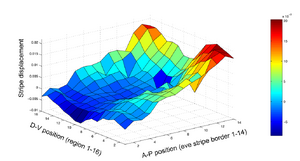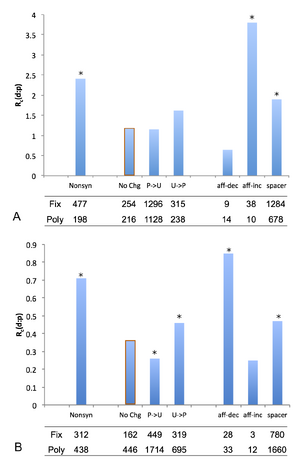Kreitman:Research
Home
Research
Internal
Lab Members
Publications
Protocol
Contact
Molecular population genetics and evolution (Drosophila and Arabidopsis)I have had a longstanding interest in molecular population genetics, and have contributed over the years to the development of methods for analyzing DNA sequence polymorphism and evolutionary data, particularly with respect to detecting the action of natural selection. Although our work has historically focused on Drosophila, we have shifted our attention in recent years to Arabidopsis thaliana and its bacterial pathogens (in collaboration with Joy Bergelson's lab). Plant resistance to bacterial disease and bacterial pathenogenicity is an immensely powerful system for investigating both the ecological and evolutionary contexts of molecular adaptation, and holds the promise of uniting the two. In collaboration with Magnus Nordborg (http://walnut.usc.edu/) and Justin Borevitz, we have completed genome-wide assessments of genetic polymorphism, have assembled at 250K SNP chip, and have genotyped hundreds of isolines derived from natural populations. We have validated genome-wide association mapping in Arabidopsis to discover disease resistance polymorphism, and intend to do the same with common bacterial pathogens. We are also carrying out metagenomic surveys of the bacterial pathogen community infecting Arabidopsis. Ever since our early studies of sequence variation and evolution in Drosophila, including noncoding regions, we have been interested in the contribution of gene regulation to adaptation. Drawing on extensive molecular analysis of the Drosophila even-skipped stripe two enhancer (eS2E) -- arguably the best characterized of any eukaryotic cis-regulatory sequence -- and a rich knowledge of the segmentation process in embryogenesis, Dr. Michael Ludwig (UC) and I have embarked on a research program to functionally dissect the evolution of this enhancer. Our approach has been to exploit transformation technology and the extensive molecular genetic arsenal available for the fly to quantitatively investigate evolved differences in eS2E performance. We are currently investigating features of the eS2E structural architecture that might contribute to functional robustness in enhancer performance, and the evolution of these features. We are also investigating developmental canalization of the segmentation process and the ability of the system to evolve in the face of this canalization. Finally, with the availability of a dozen Drosophila genome sequences, and genome-wide polymorphism data, we are functionally characterizing polymorphic and fixed differences in transcription factor binding sites with the goal of developing novel statistical methods to evaluate mechanisms of selection acting on binding site evolution (see below for a detailed description) Egg size variationWe are using several techniques to visualize the way that different selective pressures on egg size affect the spatial patterning of early segmentation genes in developing Drosophila embryos.  We have used artificial selection to generate replicate large and small egg lines. Using in situ hybridization, we triple stained these embryos for mRNA of giant (gt), and even-skipped (eve), with Sytox green as a nuclear stain. We used some innovative software called PointCloudToolbox (http://bdtnp.lbl.gov/Fly-Net/bioimaging.jsp?w=software) to compare the eve stripe patterns between the divergently selected lines, as well as number of nuclei at the periphery for mitotic cycle 14 embryos. We found that there is genetic variation for eve stripe allometry segregating in natural populations of D. melanogaster. The phenotypic difference in stripe positioning between the selected lines is neither a spatially restricted shift, nor a coordinate shift of all stripes, but a monotonically increasing (i.e., allometric) shift along both A-P and D-V axes (Figure). Genetic variation for this buffered trait was produced in the absence of environmental or genetic perturbation, and therefore must not be entirely suppressed by the developmental canalization process. Also, cycle 14 nuclear number is not constant, but differs by a mean of more than 1000 nuclei as a correlated response to divergent selection for egg size. In addition, we have generated replicate Drosophila lines (from the same base population as the selected lines) with evolved differences in egg size as a result of reducing the temperature in which they were raised. Analysis of these lines is ongoing. We derived inbred sublines from the artificially selected populations and we are currently surveying these inbred sublines for eve stripe border position along with several gap gene expression domains. Drosophila Transcriptional Enhancers EvolutionTranscription factor binding sites (TFBS) turnover (i.e. lineage specific gain and loss) is a well-documented phenomenon in eukaryote cis-regulatory modules (CRM). The wide spread of the phenomenon and the appearance of conserved expression patterns for diverged orthologous CRM led to the standing view that the observed gain and loss of TFBS were functionally and selectively neutral.  To specifically test the neutral vs. selection hypotheses for the TFBS turnover process, we analyzed natural variation patterns within and between two closely related Drosophila species in a set of experimentally defined and validated TFBS dataset (http://redfly.ccr.buffalo.edu/). We found the patterns of divergence and polymorphism for two types of mutations -- those inferred to increase or decrease the binding affinity respectively-- are not compatible with a neutral hypothesis. Instead, multiple lines of evidence suggested that positive selection have contributed to gain as well as loss of TFBS in the two lineages, with purifying selection maintaining existing TFBS in the population. This finding challenges the prevailing neutral view of the TFBS turnover process, indicating that CRM function may experience constant pressures to adapt to both external environmental changes as well as internal genetic network alterations. However, the net change in CRM function will be highly constrained due to pleiotropic effects and essentiality of the gene function, resulting in a distinct short term vs. long term evolutionary dynamics. |
